Houseplants are popular indoor decorations. Attractive and constantly changing, they add a softness of line and provide a bit of nature indoors. However, the ideal location of a plant for decoration may not be the ideal spot for plant growth. Lack of adequate light is the most common factor limiting the growth of plants in many areas of the home. Supplementary electric lighting is usually the easiest and least expensive way to provide enough light for plants that do not receive adequate natural light (Figure 1).
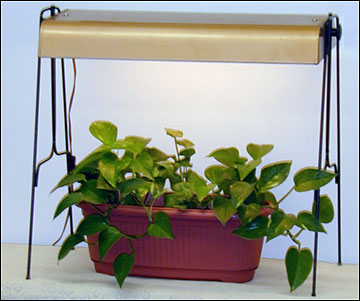 Figure 1
Figure 1
Artificial lighting, if properly designed, allows plants to be grown indoors in nearly any setting.
Why do plants need light?
Light provides the energy plants need to make the food required for them to grow and flower. Plants are the only organisms able to use the energy from light to produce sugars, starches and other substances needed by them as well as by other living organisms.
Is light color important to plants?
Certain colors or wavelengths of light are more important for plant growth than others. Leaves reflect and derive little energy from the yellow and green wavelengths of the visible spectrum. In contrast, the red and blue wavelengths of the light spectrum are the most important energy sources for plants.
Plants growing outdoors, in greenhouses or close to windows are exposed to a balance of wavelengths of light from the sun, including the blue and red light that plants need. In settings where plants receive little or no natural light, additional light from artificial sources must be provided for adequate plant growth.
What types of artificial lights are available?
There are four primary sources of artificial light available for the enhancement of plant growth: incandescent; fluorescent; high-intensity, or gas, discharge; and light-emitting diodes.
As a single light source for plants, incandescent lights are not particularly good. They are a rich source of red light but a poor source of blue. Additionally, they produce too much heat for most plants and, if used, must be located some distance from the plants, thus reducing the intensity of the light the plants receive. Important from an economic point of view, incandescent sources are inefficient in converting electrical energy into light energy. Furthermore, a standard incandescent bulb's life is often only about 1,000 hours, whereas a fluorescent tube's life is normally 10,000 hours or more.
Fluorescent tubes provide one of the best artificial light sources available for plants in the home. They are about 2-1/2 times more efficient in converting electrical energy into light energy than are incandescent sources, making them less expensive to operate. Additionally, fluorescent tubes produce relatively little heat and are available in types that emit primarily red and blue light. As mentioned above, fluorescent tubes are relatively long-lived. They are also available in many sizes and shapes, though straight tubes in 2-, 4- or 8-foot lengths are used most frequently.
High-intensity, or gas, discharge (HID) lights, such as sodium-vapor or metal halide, are frequently used in greenhouses when supplementary light is needed. They are about 10 times more efficient in converting electrical energy into light energy than incandescent sources. Additionally, their bulbs are very long-lived. However, they emit a lot of heat and the fixtures needed to operate them are large, bulky and relatively expensive. These drawbacks, along with their lack of availability in small wattages, make them questionable for use in the home.
Light-emitting diodes (LEDs) represent the newest source of supplemental light for plants. They are extremely energy-efficient and very long-lived. LED lights can be customized to produce the wavelengths of light desired. For example, LED plant lights emit only the red and blue light needed by plants. They emit very little heat and require no ballasts or reflectors. Currently, however, the price of LED systems is high when compared with other sources.
What light source is most popular for interior settings?
Given their modest initial purchase price, energy efficiency and ease-of-use, fluorescent lights are the choice of many indoor gardeners. Although cool-white fluorescent tubes remain the most popular choice, warm-white fluorescent tubes also seem fairly effective. Fluorescent tubes listed as white or daylight are less desirable for indoor plant growth. Cool-white tubes produce a small amount of red rays — in addition to orange, yellow-green and blue rays — but usually not enough for plants unless windows or other artificial lights provide additional red rays.
A few incandescent bulbs in the growing area can furnish needed red rays. A general ratio of incandescent to fluorescent light is about 3 to 10, so for every 100 watts of fluorescent light, you should provide about 30 watts of incandescent light for a better red-to-blue light balance.
The fluorescent tubes developed specifically for growing plants have a higher output in the red range to balance the blue output. Many home gardeners have found that these tubes can be used in combination with cool-white tubes. Use one plant-growing tube to each one or two cool-white tubes. This method is more economical than using all plant-growing tubes, because cool-white tubes cost less than the plant-growing tubes. Also, the plant-growing tubes use less electricity and produce less heat than incandescent bulbs, and you will not have to provide fixtures for both incandescent bulbs and fluorescent tubes.
Can I use spotlights?
Spotlights can be used to light indoor houseplants, though they are not the most effective solution. Most are incandescent and, thus, are not energy efficient; give off a lot of heat; and do not produce a good balance of red and blue light, although self-reflectorized spot lamps coated to emit more blue light are available. Reserve these special light sources for situations where supplementary light is essential but other sources cannot be used.
How much light should plants receive?
The amount of light necessary varies with each plant. In general, the light fixtures available for home plant lighting make it practically impossible to produce too much light for most plants.
Plants that can adapt to interior settings usually are divided into three general categories: those suitable for low, medium and high light intensities. (These three groups are referred to in the discussion of individual plants in the last section of this publication.) The categories generally indicate the minimum light required. Growth is often best at the higher end of these suggested light ranges.
Foot-candle
A foot-candle is a measure of light intensity, or brightness. It is defined as the amount of light received by a 1-square-foot surface that is 1 foot away from a light source equivalent to one candle of a certain type.
Low-light plants
Plants referred to as low light intensity plants generally should receive between 50 and 250 foot-candles. Under artificial light, a few plants in this group can be maintained at as little as 10 foot-candles. Low-light plants should receive between 10 and 15 watts of fluorescent light per square foot of growing space. A single fluorescent tube such as a 2-foot 20-watt tube or a 4-foot 40-watt tube without any other light provides only enough light for plants in this category (Table 1).
Table 1
Light output measured at various distances below fluorescent lamps†.
| Distance (feet) | Light output (foot-candles)‡ based on fixture type | ||
|---|---|---|---|
| 0.5 foot | 500 | 700 | 900 |
| 1 foot | 260 (200) | 400 (260) | 600 |
| 2 feet | 110 (100) | 180 (150) | 330 |
| 3 feet | 60 (60) | 100 (90) | |
| 4 feet | 40 | 60 | 100 |
† All lamps are standard 40-watt tubes.
‡ Output in parentheses is measured 1 foot on either side of a line directly below the lamps.
Medium-light plants
Medium light intensity plants prefer 250 to 1,000 foot-candles. Best growth occurs above 750 foot-candles unless plants also receive extended periods of direct sunlight. Give them artificial light in the 500 to 1,000 foot-candle range, or 15 or more watts per square foot of growing area. Although plants in this group can be held in the 250 to 500 foot-candle range, growth is best with more light. A fixture containing two fluorescent tubes is sufficient for plants in the low- to medium-light range. Adjustments in the number of tubes used may be made if you regulate the distance between the tubes and plants.
High-light plants
Plants that require high light intensity generally are less satisfactory for growing under artificial lights in the home. However, if you want to try, use special high-intensity lamps. These plants need at least 1,000 foot-candles, or 20 watts per square foot of growing area, but should have higher intensities for best growth and flowering. Fixtures containing three to four fluorescent tubes are necessary for plants requiring high light intensity.
How far from the light should I place plants?
Most plants should be located with the tips of the plants 6 to 12 inches from the light source. The intensity of light drops rapidly as the distance from the light bulbs or tubes increases. Table 1 shows this reduction of light intensity with distance below and to the side of tubes. Fluorescent tubes do not produce as much light at the ends as they do in the center, so the brightest spot under a fluorescent fixture is directly beneath the center of the tubes.
The light fixture's position should be adjustable so you can keep the distance between the light and the plant fairly constant. Fluorescent shop or workroom fixtures often are hung on chains with S-hooks for easy adjustment. These fixtures are easily raised or lowered from link to link. If the fixture is not movable, you may make some adjustment by raising plants on stands, shelves or boxes.
How long should I use lights?
In most cases, plants receiving no outdoor light should be lit from 16 to 18 hours each day. If some additional light is received, 12 to 14 hours each day may be adequate. Lights should be used at the same time that plants receive window light. Using lights at the beginning or end of the day will not usually be as effective as using lights during daylight unless natural daylight is quite bright.
How can I get the most from artificial light?
Reflectors and reflective surfaces can maximize the available light. Bulbs with self-contained reflectors are helpful.
Porcelain-coated reflectors are excellent and require little maintenance. Keep reflectors clean and free of rust or any coating that reduces their effectiveness. White paint or aluminum foil beneath or around the growing area helps reflect light and makes it more efficient.
Space plants far enough apart to allow light between them. Arrange plants so they do not shade each other. Keep tubes clean and replace old tubes promptly.
How should I light the bottom of a tall plant?
You may want to supplement light placed above a tall plant with spotlights around the base of the plant and directed on the lower leaves. You can also use fluorescent tubes in a vertical position to provide side lighting from the top to the bottom of a plant. This vertical position also can be used for smaller plants arranged on shelves (Figures 2 and 3).
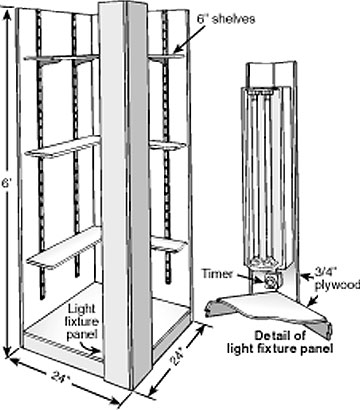 Figure 2
Figure 2
This homemade vertical lighting system with adjustable shelves can accommodate small or large plants.
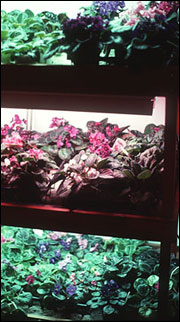 Figure 3
Figure 3
Small, low-light plants (e.g., African violets) are well suited for light gardens.
Do I really need to measure light?
Light measurements are helpful in setting up a plant growing area but should be used only as a guide. The human eye is a poor judge of light intensity because it automatically adjusts to different light levels. Light meters that measure foot-candles may be used if available. Photographic light meters normally do not read in foot-candles, but some manufacturers supply a conversion table. When available, these may also be used.
Calculating wattage per square foot of growing area is a useful and easy way to estimate light required. When using fluorescent tubes, simply multiply the wattage desired by the square feet of growing area. For example, if you have a 4-square-foot area of low-light plants that need 10 watts, the calculation would be 10 watts × 4 square feet, or 40 watts. With this approach, light measurements are unnecessary unless problems develop.
How can I tell if a plant is getting enough light?
The growth pattern of the plant can be a good indication of whether it is getting enough light. No growth may indicate poor light but could be a sign of other problems as well. The signs that a healthy plant is not getting enough light include development of long internodes (length of stem between leaves) or of smaller-than-normal leaves; pale green stems and foliage; and lower leaves that are yellow and dropping.
What window provides the best light?
When choosing windows to place plants near, consider size, direction, overhang and shade from trees or buildings. Large windows provide the best growing conditions and allow plants to be placed fairly far back into a room. But even low-light plants usually do not receive enough light at distances greater than 10 feet from an average window. The best windows for plants are those not shaded by a large overhang, trees or structures.
Windows facing south provide the brightest light conditions for the longest duration. In winter, any houseplant benefits from the light of a south window. However, plants that do not need bright light may be sunburned by the bright light at south windows in late spring, summer or early fall. Place plants requiring less light, such as African violets, at a north window or to the side or interior of a large south window during these times. South windows are most appropriate for plants requiring bright light and some direct sunlight.
East and west windows are well suited to many plants in the medium light range, whereas north windows are satisfactory only for plants requiring the lower light levels. These plants should not receive direct sunlight.
Can lights keep plants from blooming?
Some plants, generally known as short-day plants, can be kept from flowering under the light durations normally used for artificial lighting. Best known in this category are the poinsettia and chrysanthemum. To induce flowering indoors, give these plants only about 10 hours of light each day until flowers become visible and color shows.
Will artificial lights start seeds?
Vegetable, annual flower and some perennial flower seeds may be started successfully indoors under lights for later planting in the garden. For stocky growth, place seedlings within a few inches of the tubes as soon as germination begins.
Is a light timer necessary?
A timer is a valuable asset because lights should be turned on and off regularly and consistently. Twenty-four-hour timers available from electrical supply houses are adequate. The electrical cord from the timer should be the three-prong type, or you should use a grounded adapter. The use of water around plants makes grounding electrical fixtures important.
Plants for indoor lighting
- African violet, Saintpaulia species
This is one of the most satisfactory flowering plants for growing under lights; it grows and flowers well between 500 and 1,000 foot-candles. Light 16 to 18 hours each day. - Aluminum plant, Pilea cadierei
This small plant with colorful leaves tolerates a low light level but needs high humidity. Other suitable related plants include artillery fern and moon valley pilea. - Arrowhead vine, Syngonium podophyllum
These small plants are bushy and later, creeping or climbing. They may be kept at a low light level, but they are denser at a medium level. - Asparagus ferns, Asparagus densiflorus 'Sprengeri' and Asparagus setaceus (formerly plumosus)
These durable potted plants with fleshy roots produce fernlike leaves. Although tolerant of low light, the plants grow more abundantly and densely in a medium light range. - Aucuba-leaf croton, Codiaeum 'Aucubaefolium'
Crotons are not appropriate as indoor plants because they require high light for good color development and growth. However, this smaller type with yellow spots can be grown at medium light intensities. - Begonias: Angelwing, Begonia coccinea; Beefsteak, B. xerythrophylla; Iron cross, B. masoniana; Flowering, B. semperflorens; and Painted B. rex varieties
Most plants of this family are suitable for growing in the medium light range. Begonias like high humidity and constantly moist soil. Give them a long light duration, from 14 to 18 hours each day. - Cacti and succulents
Many plants may be grouped in this general category. These plants need high light intensities; most are not satisfactory for growing under artificial lights. However, you can use lights to maintain them for limited periods when they cannot be exposed to bright light or direct sunlight. When artificial lights are used, provide high intensities, and keep plants close to the source. - Cast iron plant, Aspidistra elatior
This plant tolerates cool locations and poor light; it is one of the best plants where only low light conditions exist. A variegated form is also available. - Chinese evergreen, Aglaonema modestum
Aglaonemas are relatively small tropical plants but can tolerate light as low as 10 foot-candles. Other species with different leaf form and variegation are also available. - Cissus species: Grape ivy, Cissus rhombifolia; and Kangaroo vine, Cissus antarctica
Cissus are climbing plants that prefer medium light conditions for best growth, although kangaroo vine tolerates lower light. Although better for greenhouse culture, another beautiful relative is the rex begonia vine, Cissus discolor. - Dieffenbachia, Dieffenbachia maculata
Many satisfactory species and varieties are available. Plants have large, showy leaves with spotting and variegation. Medium light range is best and will prevent loss of lower leaves. Overly tall plants can be cut back. Dieffenbachia benefits from supplementary lighting in poorly lit areas. - Dracaena species: Corn plant, Dracaena fragrans massangeana; Dragon tree, Dracaena marginata; Janet Craig dracaena, Dracaena deremensis 'Janet Craig'; and Ti plant, Cordyline terminalis 'Ti'
Most dracaenas become large plants. They are well adapted to house conditions and tolerate low light although they also do well in medium light. They need to be kept warm and constantly moist for best growth. Ti plant develops best leaf color in bright light and therefore is less suitable for locations where it receives only artificial light. - Ferns: Birdsnest fern, Asplenium nidus; Boston fern, Nephrolepis exalta bostoniensis; Holly fern, Cyrtomium falcatum; and Maidenhair fern, Adiantum species
The word "fern" brings to mind the Boston, or sword, fern with its many varieties. These ferns are durable houseplants that tolerate low light but prefer a medium light level. Keep them cool and moist. Holly fern likes cooler house temperatures; however, birdsnest fern prefers warmer temperatures. Ferns may develop brown leaves or leaflets at low humidity. Maidenhair ferns should never be allowed to become dry. - Ficus species: Rubber plant, Ficus elastica varieties; fiddleleaf fig, Ficus lyrata; and weeping fig, Ficus benjamina
These large plants are well suited to most home conditions and are best grown in a medium light range. Low light may result in a drop of foliage. Keep soil evenly moist. They tolerate low humidity. - Flame violet, Episcia cupreata varieties
These close relatives of the African violet have beautiful foliage in many color patterns. Flowers are red, pink, purple and yellow. Light needs are the same as for African violets. The plants need high humidity and temperatures that do not drop below 65 degrees F. - Gloxinia, Sinningia speciosa fifyana varieties
This colorful African violet relative needs a medium light range to prevent elongation of the stems as well as to promote abundant flowering. Buds sometimes appear but fail to develop, which may indicate insufficient light, too low humidity or mite damage. - Herbs
Culinary herbs can be grown indoors, but for best growth, most of these require fairly bright light. If you attempt them under artificial light, use as much light as possible with a long duration. - Hoya: Hindu rope plant, Hoya carnosa 'Hummels compacta'; and wax plant, Hoya carnosa
Hoyas are vining plants with thick, waxy leaves. They tolerate low light but need medium light to grow and high light to flower. Plants should not be moved; allow them to remain undisturbed. Keep slightly cooler and drier in winter. - Ivy, Hedera helix varieties
These vining plants with leathery leaves grow best in medium to bright light areas. They need constant moisture to prevent leaf drop, and they tend to grow better when kept slightly cool indoors. - Jade plant, Crassula argentea
This succulent plant is well adapted to indoor conditions. Although most crassulas prefer sun, jade plant will tolerate lighting as low as 25 foot-candles; however, growth will be thin and leaves small. Avoid overwatering and tight soils. - Little-leaf schefflera, Schefflera arboricola
This medium-sized plant has waxy leaves that are made up of leaflets that begin at a shared point near the based of the leaf and radiate outward much like fingers from the palm of an open hand. It has a bushy type of growth and, although it prefers higher amounts of light, it will tolerate medium light quite well. - Norfolk Island pine, Araucaria heterophylla (formerly excelsa)
This is a durable plant for home conditions. Although tolerant of poor light, it develops better growth in medium light conditions. With poor care and low light, it may lose symmetry. - Orange: Dwarf or calamondin, Citrus mitis
Potted citrus plants prefer bright light for best growth and fruiting. You may keep them at medium light intensities during midwinter. The calamondin orange is the most popular potted citrus, although Meyer lemon and Ponderosa lemon are also satisfactory for home use. - Orchids
Few orchid species are well suited to the average home's artificial light conditions. Seedling plants do well under artificial lights; however, mature plants need bright light for best growth and flowering. Some genera better adapted to the light garden include Epidendrum, Paphiopedilum, Brassavola and Phalaenopsis. All orchids need excellent drainage and air movement. - Palms: Areca palm, Crysalidocarpus lutenscens; Dwarf date palm, Phoenix roebelenii; Neanthe bella palm, Chamaedorea elegans 'Bella'; Bamboo palm, Chamaedorea erumpens; and Kentia palm, Howeia forsteriana
Neanthe bella and kentia palms are most tolerant of low light conditions. Other palms are best suited to medium light areas. Bright light may cause fading in some species. Palms prefer fairly uniform moisture, but occasional slight drying can be beneficial. Palms grow relatively slowly indoors. Keep close watch for spider mite damage. - Peperomias: Baby rubber plant, Peperomia obtusifolia; Emerald ripple, Peperomia caperata; and many other suitable species
Most peperomias have fleshy leaves and stems. They are small plants well adapted to home conditions. Provide a medium light level, although peperomias can tolerate poor light for limited periods. Avoid overwatering, which may promote stem rots. - Philodendrons: Heartleaf philodendron, Philodendron oxycardium; Splitleaf philodendron, Philodendron pertusum; and other suitable species
The heartleaf philodendron tolerates low light; most prefer a medium light range for best growth indoors. Most are well adapted to home growing. They should be maintained at fairly uniform moisture. - Pilea species
These small but colorful plants (for example, Pilea caperata, Emerald ripple pilea) are excellent choices for table tops, dish gardens and terrariums. They require the same light conditions as do the peperomias. - Pleomeles: Lance dracaena, Pleomele reflexa; and Malaysian dracaena, Pleomele thaliodes
These plants are gaining popularity because of their durability as potted plants and tolerance to low light conditions. They grow best in a medium light range with uniform soil moisture. - Pothos, devil's ivy, Epipremnum aureus
This popular variegated climbing vine is similar to heartleaf philodendron and satisfactory for low and medium light conditions. It requires less uniform moisture than philodendron. - Sansevieria, snake plant, mother-in-law-tongue, Sansevieria trifasciata
This very popular and durable plant grows well indoors. It tolerates poor light but makes best growth in medium to bright light conditions. Dwarf and variegated forms are available. Avoid overwatering. - Schefflera, umbrella tree, Brassaia actinophylla
This plant prefers bright light but tolerates medium light or even low light for limited periods. It will drop foliage in extended periods of poor light or if kept too wet or too cool. Spider mites are a common problem. - Spathiphyllum, peace lily, Spathiphyllum species, for example, 'Supreme' or 'Sensation'
These plants adapt to low light conditions but need medium light to flower. Their white, anthurium-like flowers are long-lasting. Do not allow plants to dry out. - Spider plant, airplane plant, Chlorophytum comosum 'Vittatum'
Long drooping leaves and runners producing small plants make this a popular hanging plant. Solid green and variegated types are available. They tolerate low light but grow best in the medium range. Keep well watered. - Swedish ivy, Plectranthus australis
This creeping plant is used for hanging containers. Although it tolerates low light, more dense growth and branching occur at medium light intensities.
Original author
Ray R. Rothenberger
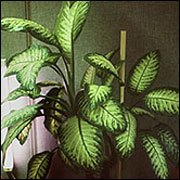 Figure 4
Figure 4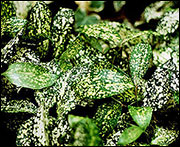 Figure 5
Figure 5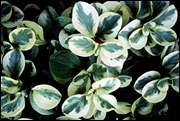 Figure 6
Figure 6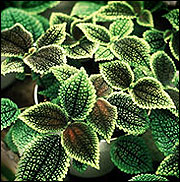 Figure 7
Figure 7